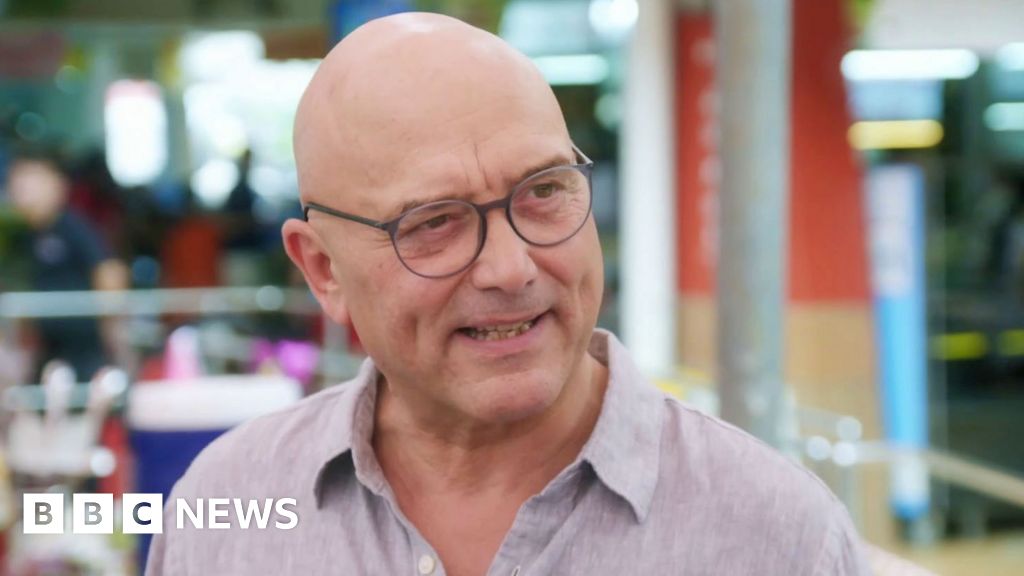ARTICLE AD BOX
By Greig Watson
BBC News
TV presenter Professor Alice Roberts described the mosaic as important and exceptional
A lavish Roman mosaic found beneath a farmer's field in Rutland has been described as the find of the century - but what does it tells us about the people who made it? BBC News digs a little deeper.
Professor Alice Roberts says she deliberately avoided looking at advance pictures of the incredible Roman mosaic - part of a villa uncovered beneath farmland - so that her first reactions on camera would genuinely reflect her amazement.
The University of Birmingham professor and TV presenter filmed the find for the TV series Digging for Britain, due to be broadcast in January.
"It is difficult to articulate how important and exceptional it is," she said.
Image source, Historic England
Image caption,The most dramatic of the mosaic's three panels, with a naked Achilles attacking Hector
The 11m x 7m (36ft x 23ft) floor has three panels showing a climatic moment from the Trojan war in which the Greek hero Achilles fights, kills and then ransoms the body of his Trojan opponent Hector.
"Many of these floors have geometric patterns or portray one god or other but there is no argument about this, the story is laid out almost like a cartoon," said Professor Roberts.
"We spoke to the foremost mosaic expert in the country and he said it was the find of his lifetime.
"Nothing like it has been found in Britain for 100 years."
Image source, Historic England
Image caption,The full mosaic, showing panels running from right to left and damage from later phases of use
The complex, which was discovered in 2020, has been worked on by a team from the University of Leicester.
And what the mosaic - dated to between the 3rd and 4th Century AD - reveals may overturn popular ideas about life under the Emperors.
Perhaps surprisingly, the part of the story John Thomas, deputy director of University of Leicester Archaeology Service, first mentions is the end of its working life.
"At some point, a hearth has been built on it in one corner, while another section has just been dug away for a fire," he said.
"It could have been locals moving in, it could have been the family which had owned it for years.
"But either way, the floor and its imagery were no longer valued.
"This high status, expensive luxury room had been turned into an area for cooking."
Image source, Ermine Street Guard
Image caption,The Roman army conquered much of Britain - but did the country adopt Roman culture?
Mr Thomas believes that fact alone suggests much about how dramatically the world had changed in the life of the building and the people who lived in it.
For around 350 years Britain was part of the Roman world, but historians are not clear whether Imperial rule ended swiftly and violently or simply ebbed away.
One of the enduring mysteries of this period was - just how Roman was Britain?
Was it a barely pacified, muddy hut-filled foggy rock on the edge of the known world or a fully paid-up member of the imperial fan club?
Image source, Getty Images
Image caption,How the mosaic room may have been used in its heyday - this reconstruction based on Lullingstone Villa
Dr Jane Masséglia, lecturer in ancient history at the university, says the mosaic gives us an insight into the minds - and the world - of our ancestors.
"Images of the Trojan war are everywhere in the Roman Empire - apart from Britain, it was thought," she said.
"This reinforced the idea of Britain as something of a cultural backwater, lacking in the sophistication of a proper classical education.
"But the Rutland mosaic has challenged that."
Image source, ULAS
Image caption,Hector's body is weighed against gold, crucially a scene not in Homer's account of the Trojan war
She describes the commissioning of the piece as a big statement, particularly given the origins of the subject matter.
Two of the scenes have details not from the familiar account of the Trojan War - Homer's Iliad - but rather a lost version by the heavyweight Greek playwright Aeschylus.
"He was rather like the Shakespeare of ancient Greek writing," she said.
"Using this rather niche version of the story is rare in the Empire and unknown in Britain.
"It was a bit like someone wallpapering their best room with quotes from Hamlet."
Image source, Getty Images
Image caption,The villa may have been like this one at Cargrave, North Yorkshire - a complex of buildings fitted into a social and economic network
The mosaic also sheds light on the distant lives of those who lived in the villa.
Dr Masséglia said the mosaic showed "high Mediterranean culture".
"The owners were pushing at being Roman, a consciously ostentatious display of identity."
"Mosaics are high status, so these people were rich," said Mr Thomas.
"And you don't pay all that money for such a floor and keep it to yourself, so it was designed to be shown off.
"This villa was part agricultural centre and part pleasure palace, at the centre of a network of other villas, with towns and roads close by.
"There would have been guests visiting to entertain and impress, a community that was looking to demonstrate its culture."
Image source, Historic England
Image caption,The room's change of fortune is suggested by two graves being dug in the post-Roman period
But nothing, not even Rome, lasts for ever. The mosaic shows a high quality repair in one corner, but then decline sets in.
The centre of the floor has subsided into an old ditch and has not been corrected.
Then, at some later point, the fires have been lit on the once glorious floor.
"It shows people were still living here and there was likely still some sort of roof on the walls," said Mr Thomas.
"But we will need samples carbon dated to give us a better idea of when this happened.
"It will be fascinating to put a date to this phase of the villa".
The reversal in status is suggested by the fact the area was even used for two burials.
Image source, Historic England
Image caption,Less than 3% of the complex has been excavated and the team believe new revelations could still be hidden
For all the mosaic has revealed already, the lure of what is yet to be found is palpable.
The team said less than 3% of the villa has been excavated and studies at the site - its exact location is being kept a secret - will continue.
"The mosaic is the focus, and it is absolutely stunning, but it represents one layer in time," said Professor Roberts.
"We can also hope to understand what happens in the landscape before the Romans arrive and to the villa over time."
Dr Masséglia casts the net even wider.
"There is probably a patchwork of villas underneath our feet waiting to be found," she said.
"It may well give us an ever expanding idea of how outward-looking and integrated Britain was with the rest of the world."
The discovery of the Rutland villa will be featured as part of Digging for Britain on BBC Two and iPlayer in early 2022.
Follow BBC East Midlands on Facebook, Twitter, or Instagram. Send your story ideas to eastmidsnews@bbc.co.uk.
Around the BBC
Related Internet Links
The BBC is not responsible for the content of external sites.

 3 years ago
68
3 years ago
68








 English (US) ·
English (US) ·